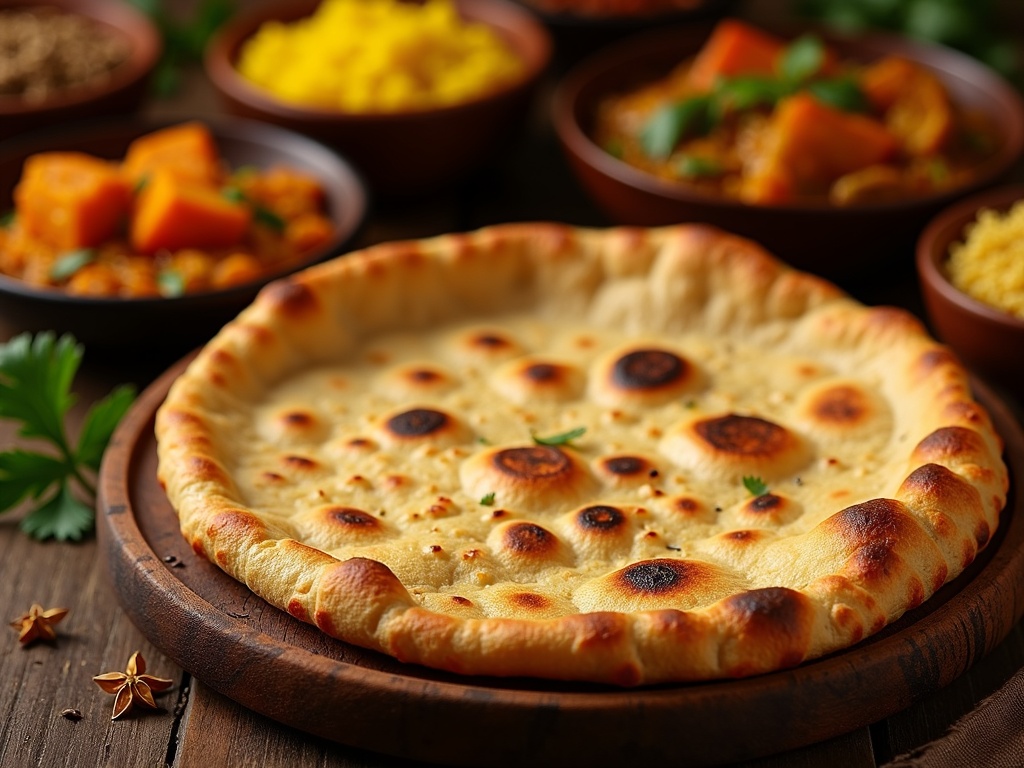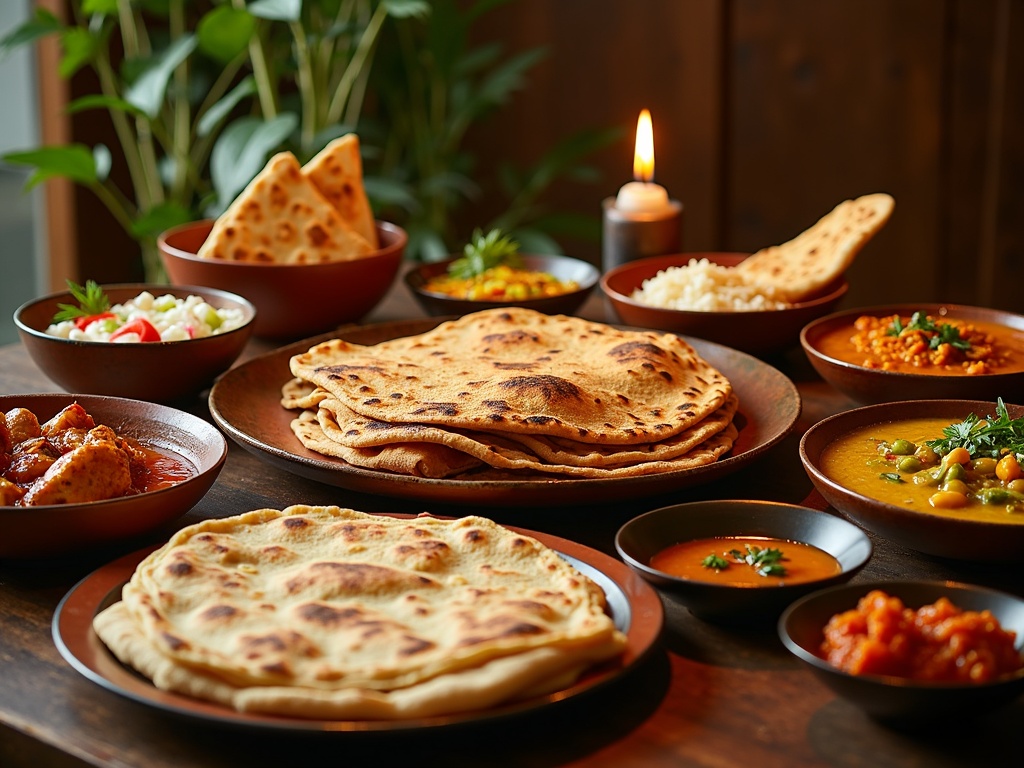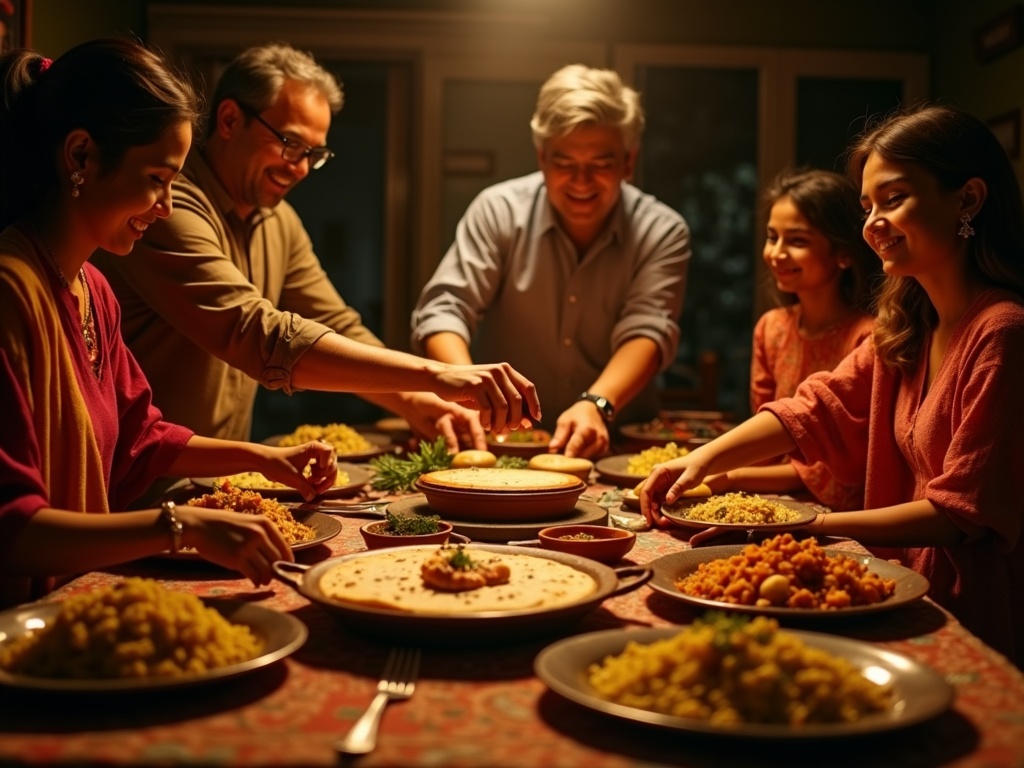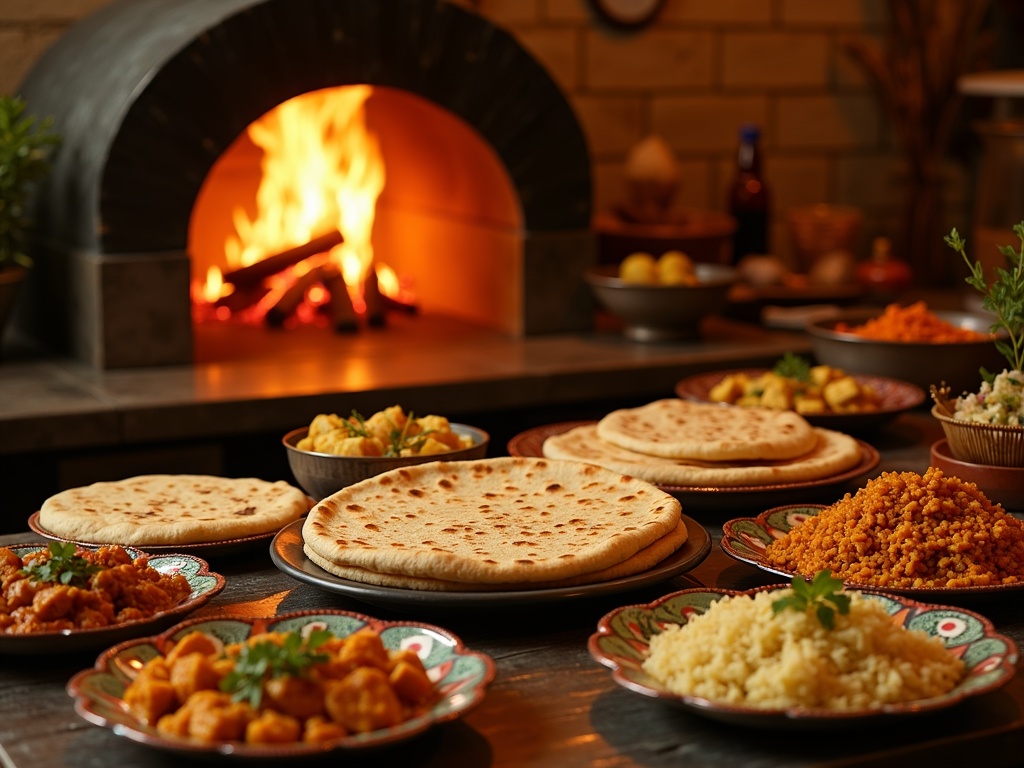Tandoori roti, a cornerstone of Indian cuisine, derives its distinctive qualities from being cooked in blazing hot clay tandoors reaching temperatures of 900°F or higher. This traditional unleavened flatbread made from whole wheat flour transforms during its brief 1-3 minute cooking time, developing a slightly charred exterior while maintaining a soft, chewy interior that other cooking methods can’t match.
Find In This Article
Key Takeaways
- Tandoori roti offers excellent nutritional benefits with approximately 130-150 calories per serving, 3-4g of protein, and 2-3g of dietary fiber, making it a healthier alternative to many commercial breads.
- The flatbread comes in several variations including plain, garlic-infused, spiced with seeds or herbs, and stuffed versions with fillings like potato or paneer.
- It pairs perfectly with rich dishes like butter chicken, vegetable curries, and lentil preparations, while also finding modern applications in fusion cuisine as wraps or pizza bases.
- Tandoori roti holds cultural significance in Indian communities, representing hospitality and togetherness during family gatherings and special occasions.
- The bread has gained international recognition beyond South Asian communities, becoming a staple on restaurant menus worldwide due to its authentic flavor, versatility, and appeal to health-conscious consumers.
What Makes Tandoori Roti Special
I find tandoori roti to be one of the most distinctive breads in Indian cuisine, largely due to its unique preparation method and simple ingredients. This traditional unleavened flatbread is made primarily from whole wheat flour, known as “atta” in Indian households. Unlike many western breads that rely on yeast, tandoori roti depends on skilled handling of the dough and high heat to achieve its characteristic texture.
The true magic happens in the cooking process. As the name suggests, tandoori roti is cooked in a tandoor – a traditional clay oven with walls that reach scorching temperatures of 900°F or higher. When slapped against these blazing hot walls, the dough undergoes a remarkable transformation in just 1-3 minutes. This quick cooking time creates the bread’s signature slightly charred exterior while maintaining a soft, chewy interior that other cooking methods simply can’t replicate.
Variations and Nutritional Benefits
Tandoori roti comes in several delightful variations to suit different preferences:
- Plain tandoori roti highlights the natural nuttiness of whole wheat
- Garlic-infused versions add aromatic depth to the flatbread
- Spiced variations incorporate ingredients like carom seeds, cilantro, or fenugreek
- Stuffed rotis contain fillings like potato, cauliflower, or paneer
The nutritional profile of tandoori roti makes it stand out from other breads. It’s naturally low in fat while offering high fiber content thanks to the whole wheat flour. This makes it an excellent companion for rich dishes like flavorful butter chicken or homemade paneer masala.
I particularly enjoy how tandoori roti pairs with various rice dishes. The contrast between the chewy texture of the bread and the fluffy grains of aromatic jeera rice or traditional pilau rice creates a balanced meal.
For those who appreciate variety in their Indian feast, tandoori roti works beautifully for scooping up hearty vegetable curry or for dipping into rich gravies. Its sturdier texture holds up well to these saucy dishes, unlike its softer cousin, buttery naan bread, which has its own unique charm.
The distinctive charred spots and subtle smoky flavor that only a tandoor can impart make this bread truly special – it’s this authentic cooking method that transforms simple ingredients into something extraordinary.
Health Benefits and Nutrition Facts
Tandoori roti stands out as a nutritionally balanced bread option that offers substantial health benefits. A single piece (50g) of this traditional flatbread contains approximately 130-150 calories, making it a relatively light choice for those watching their caloric intake.
Nutritional Breakdown
The nutritional profile of tandoori roti is quite impressive. Each serving provides about 3-4g of protein, which is essential for muscle maintenance and overall body function. It contains just 1-2g of fat, significantly lower than many other bread options available. The carbohydrate content ranges between 25-30g, providing necessary energy, while the 2-3g of dietary fiber supports digestive health.
I’ve found tandoori roti to be a healthier alternative to many commercially available bread products. Its primary ingredient—whole wheat flour—contributes significantly to its nutritional value. Unlike refined flour products, whole wheat retains the bran and germ portions of the grain, preserving essential nutrients like B vitamins, iron, and magnesium.
The fiber content in tandoori roti deserves special mention as it plays a crucial role in maintaining digestive health. This dietary fiber helps regulate bowel movements, prevents constipation, and contributes to a feeling of fullness, which can aid in weight management.
Tandoori roti pairs perfectly with protein-rich dishes like flavorful paneer masala or a hearty vegetable curry to create a balanced meal. For a complete dining experience, I often serve it alongside aromatic jeera rice or fragrant pilau rice.
The minimal fat content in tandoori roti makes it a smart choice for heart-conscious diners. Unlike its cousin, butter naan, which contains more fat, tandoori roti offers similar satisfaction without the additional calories. This makes it an excellent option for those looking to enjoy Indian cuisine while maintaining a balanced diet.
For a complete meal with balanced nutrition, tandoori roti complements protein-rich dishes like butter chicken perfectly, creating a satisfying dining experience without excessive calories.

Perfect Pairings and Modern Applications
Tandoori roti serves as the perfect canvas for countless Indian dishes, balancing flavors and providing the ideal tool to scoop up delicious gravies. I’ve found that the slightly charred, smoky flavor of tandoori roti creates a magical harmony with both traditional Indian fare and modern fusion cuisine.
Classic Companions for Tandoori Roti
The magic of tandoori roti truly shines when paired with the right dishes. These combinations have stood the test of time for good reason:
- Rich, creamy curries like butter chicken or paneer masala – the roti’s slightly smoky flavor cuts through the richness perfectly
- Hearty lentil dishes such as dal makhani or yellow dal tadka provide protein and complement the bread’s rustic texture
- Vegetable curry with its medley of seasonal vegetables creates a balanced meal when paired with tandoori roti
- Chole (chickpea curry) offers a protein-packed option that pairs beautifully with the bread’s earthy notes
- Grilled meats like Chicken Tikka with their charred exterior match the roti’s own flame-kissed character
I’ve discovered that tandoori roti has broken free from traditional boundaries and found its way into contemporary kitchens. It now serves as a versatile wrap for fusion sandwiches, replacing tortillas for healthier burritos, or as a base for quick pizzas topped with fusion ingredients.
For a complete meal, I recommend serving tandoori roti with a side of jeera rice or pilau rice, a cooling raita, and pickled vegetables. This combination creates a balanced plate with contrasting textures and complementary flavors.
While tandoori roti holds its own against hearty dishes, don’t underestimate its pairing potential with butter naan for a bread basket that offers textural variety. The thinner, crisper roti alongside the softer, more pillowy naan gives guests options to match with different dishes.
Whether keeping it traditional or experimenting with global fusion, tandoori roti proves itself as one of the most adaptable Indian breads, ready to complement virtually any meal you can imagine.

Cultural Heritage and Traditions
The tandoori roti holds a special place as a cornerstone of North Indian cuisine, carrying centuries of tradition in every bite. I’ve seen firsthand how this simple yet significant bread connects people to their cultural roots while bringing families together around the dinner table.
Symbol of Community and Sharing
In Indian households, tandoori roti represents more than just food—it embodies the spirit of hospitality and togetherness. When served alongside rich dishes like traditional butter chicken or flavorful paneer masala, it becomes part of a communal dining experience where sharing is central.
The making of tandoori roti often becomes a family activity during special occasions:
- Wedding celebrations feature freshly made roti stations where guests can watch skilled cooks slap the dough onto tandoor walls
- Religious festivals highlight tandoori roti as an offering and shared blessing
- Family gatherings center around the tandoor, with different generations participating in the bread-making process
What makes tandoori roti truly special is the ancient cooking techniques that have survived through generations. The clay tandoor oven itself dates back thousands of years, with archaeological evidence suggesting similar ovens were used in the Indus Valley Civilization. The method of slapping the dough against the hot inner walls requires skill that grandparents proudly pass down to younger family members.
In today’s fast-paced world, tandoori roti represents cultural preservation at its finest. Many families maintain a traditional tandoor at home despite modern conveniences, keeping alive cooking methods that could otherwise be lost. This commitment to heritage is often paired with adaptations—serving tandoori roti alongside fusion dishes or innovative vegetable curries.
The bread’s importance extends beyond the home kitchen. Community celebrations often feature large tandoors where dozens of rotis are prepared simultaneously, creating a focal point for gathering. The distinctive charred aroma draws people together, while the shared experience of breaking bread strengthens cultural bonds across generations.
When enjoying tandoori roti with aromatic jeera rice or other accompaniments, I’m not just tasting food—I’m participating in a living tradition that continues to adapt while honoring its roots.

International Recognition and Market Growth
The humble tandoori roti has transcended its South Asian roots to become a globally recognized culinary star. I’ve noticed how this traditional unleavened bread has captured the hearts and palates of food enthusiasts worldwide, creating ripples across international food scenes that extend far beyond Indian restaurants.
Global Expansion Beyond Borders
Tandoori roti’s journey from local staple to international sensation reflects broader changes in global food preferences. What was once primarily enjoyed within Indian communities has now secured a permanent place on menus across continents. The authentic, smoky flavor of tandoor-baked flatbread offers a taste experience that diners worldwide have embraced enthusiastically.
The US restaurant market has particularly fueled this growth. Major metropolitan areas like New York, Chicago, and Los Angeles feature countless establishments where tandoori roti serves as both a side dish and focal point. Even small towns across America now boast Indian restaurants where tandoori roti appears alongside more familiar dishes like butter chicken and paneer masala.
Similarly, the UK has long maintained a special relationship with Indian cuisine. Tandoori roti appears on menus from high-end London establishments to neighborhood takeaways. It’s often served alongside vegetable curry or as an accompaniment to pilau rice dishes, creating complete meal experiences that satisfy British diners’ growing sophistication about authentic Indian food.
What makes tandoori roti especially appealing to international audiences is its versatility. This flatbread works beautifully across dining contexts:
- As a complement to traditional curries
- Served with fusion dishes that blend Indian flavors with local ingredients
- Featured in quick-service wraps and street food adaptations
- Paired with international dips and spreads
- Offered as a healthier alternative to other bread options
The expanding unleavened bread market has created perfect conditions for tandoori roti’s growth. As consumers become more health-conscious, many appreciate its simple, wholesome ingredients. The minimal use of fat and absence of leavening agents make it attractive to those seeking cleaner eating options compared to many Western bread alternatives.
Tandoori roti has also benefited from broader ethnic food trends. I’ve observed how consumer interest in authentic global cuisines has soared, with diners increasingly seeking genuine flavors rather than adapted versions. The distinctive cooking method—in a clay tandoor oven at high temperatures—creates a product that can’t be replicated by mass production, giving it special appeal in a market that values authenticity and craftsmanship.
Restaurant operators have recognized this potential, with many investing in authentic tandoor ovens despite their cost and space requirements. The visual aspect of tandoor cooking has even become part of the dining experience in some establishments, where chefs prepare roti in view of customers, adding entertainment value to the culinary experience.
Food delivery services have further expanded tandoori roti’s reach, allowing consumers to enjoy it at home alongside other favorites like jeera rice. The bread travels reasonably well, maintaining much of its distinctive texture and flavor even after delivery.
The continued international growth of tandoori roti seems assured as global palates become increasingly adventurous and appreciation for authentic ethnic foods deepens. Its simple ingredients, distinctive preparation method, and perfect companionship with both traditional and fusion dishes position it for sustained popularity in the international food landscape.
Sources:
Nutritional Information of Bread Types, Journal of Food Science and Technology
The History of Tandoori Cooking, Culinary Heritage Review
Global Bread Market Trends, Food and Beverages Market Analysis Report

